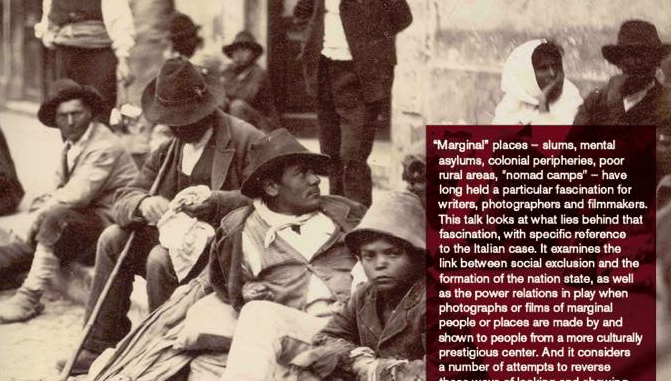
Marginalization, in one form or another, is an inevitability in the formation of nations. Italy, which was properly unified over the course of the 19th century, was no exception.
In “Italy’s Margins in Photography and Film,” a lecture by David Forgacs, the New York University professor examined the cultural history of Italian photographers and filmmakers documenting those in Italy’s “margins” — the impoverished urban peripheries, indigenous people colonized by Italians, the rurality of southern Italy, the mental asylums of the nation, and “nomad camps,” or fast-track deportation centers.
Even in examining these margins, Forgacs provided a meta-investigation of the examination process itself. There’s a power dynamic established between the documentarian and subject along lines of technology. The viewer, Forgacs argues, always sees from the perspective of the documentarian; a poor immigrant in a deportation center cannot necessarily examine the documentarian in the same way, lacking the means of capturing and publishing images.
The lecture was sponsored by the Luigi and Anita Traverso Endowment for Italian Studies, the Italian Studies Program, and the Department of Languages, Literature and Culture as part of a series designed to integrate Italian Studies with intersecting fields of research.
“What we’re trying to do is to continue working within the humanities and making the case for Italian studies by reaching out to different departments,” said Marinella Garatti, lecture coordinator and associate professor of Italian Studies. “If you look at what we’ve done, historically, in this program, we’ve had topics that reach out to other students, to other professors, to other disciplines. In this case, we were very interested in [David Forgacs’s] work.”
Forgacs hopes that the ultimate takeaway from his lecture is a better understanding of how marginalization and the examination thereof is “an intrinsic part of Italian history.”
“Since the beginnings of the Italian state in the 1860s, the process of aggregation and making Italians more similar to each other has pushed some people to the edges,” he said. “Those people who don’t speak standard Italian, who speak a dialect, who speak a minority language or are of other origin tend to find it harder to integrate into the system.”
Whether it depicts the face of an asylum inmate pressed against fencing or an Eritrean woman being roughly handled by Italian settlers, a common thread runs through every work displayed on the screen backing Forgacs: these are the forgotten people of the world, the ones larger society have labeled and discarded as untouchables. And for those dialed into current international events, this lecture could not be timelier.
“The refugee crisis and the Roma situation are two really contemporary examples of people being marginalized in a massive way, not just in Italy, but all over Europe,” Forgacs explained. “The refugee crisis has to do with the European Union blockading its borders, letting in people who have money and a job and keeping out those who don’t. I think it’s a very good example of how this maintenance of margins is continuing.”
David Forgacs’s book, “Italy’s Margins: Social Exclusion and Nation Formation Since 1861,” was released earlier this year. For more information on the Italian Studies program or the Luigi and Anita Traverso Endowment for Italian Studies, contact Italian Studies Program Coordinator Bryan Cracchiolo at cracchib@newpaltz.edu or 845-257-3504.
